First, I'll present an example below for you to see how it works. The code below generates the route between two coordinates.
library(googleway)
set_key( "API KEY")
#databases
df<-structure(list(Properties = c(1,2),
Latitude = c(-24.930473, -24.95575),
Longitude = c(-49.994889, -49.990162),
cluster = c(1,2)), class = "data.frame", row.names = c(NA, -2L))
df1<-structure(list(Properties = c(3,4),Latitude = c(-24.924361,-24.95575),
Longitude = c(-50.004343, -50.007371),
cluster = c(1,2)), class = "data.frame", row.names = c(NA, -2L))
#Table to join df and df1
data_table <- rbind(df,df1)
data_table<-data_table[c(2:3)]
df2<-google_directions(origin = data_table[1,], destination = data_table[3,],
mode = "driving") #I specified properties 1 and 3 which are from cluster 1
df_routes <- data.frame(polyline = direction_polyline(df2))
m1<-google_map() %>%
add_polylines(data = df_routes, polyline = "polyline")
Now, I'm trying to do this in Shiny, but without specifying the coordinates of the properties like I did in the example above. In this sense, I created a selecInput to select which cluster I want to see the route. How to adjust this in this code below?
This question can help: Adjust new features in shiny
library(shiny)
library(rdist)
library(geosphere)
library(shinythemes)
library(googleway)
set_key( "API KEY")
function.cl<-function(df,df1,k,Filter1){
#database df
df<-structure(list(Properties = c(1,2),
Latitude = c(-24.930473, -24.95575),
Longitude = c(-49.994889, -49.990162),
cluster = c(1,2)), class = "data.frame", row.names = c(NA, -2L))
df1<-structure(list(Properties = c(3,4),Latitude = c(-24.924361,-24.95575),
Longitude = c(-50.004343, -50.007371),
cluster = c(1,2)), class = "data.frame", row.names = c(NA, -2L))
#Table to join df and df1
data_table <- rbind(df,df1)
data_table1<-data_table[c(2:3)]
#Generate the map with routes
df2<-google_directions(origin = data_table1[1,], destination = data_table1[3,],
mode = "driving")
df_routes <- data.frame(polyline = direction_polyline(df2))
m1<-google_map() %>%
add_polylines(data = df_routes, polyline = "polyline")
plot1<-m1
return(list(
"Plot1" = plot1,
"Data" = data_table
))
}
ui <- bootstrapPage(
navbarPage(theme = shinytheme("flatly"), collapsible = TRUE,
"Cl",
tabPanel("Map of all clusters",
sidebarLayout(
sidebarPanel(
tags$b(h3("Choose the cluster number?")),
sliderInput("Slider", h5(""),
min = 2, max = 2, value = 2),
selectInput("Filter1", label = h4("Select just one cluster to show"),""),
),
mainPanel(
tabsetPanel(
tabPanel("Solution", (google_mapOutput("G2",width = "95%", height = "600")))))
))))
server <- function(input, output, session) {
Modelcl<-reactive({
function.cl(df,df1,input$Slider,input$Filter1)
})
output$G2 <- renderGoogle_map({
Modelcl()[[1]]
})
observeEvent(input$Slider, {
abc <- req(Modelcl()$Data)
updateSelectInput(session,'Filter1',
choices=sort(unique(abc$cluster)))
})
}
shinyApp(ui = ui, server = server)

